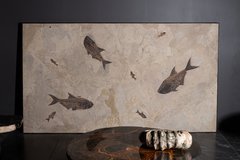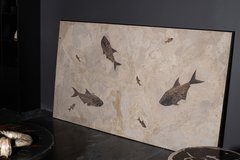Plate with fishes Diplomystus sp. and Knightia sp.
Specifications
- Found:
- Green River, Wyoming, USA
- Genus:
- Diplomystus
- Overall size:
- 220*123*4 cm (86.61*48.43*1.57")
- Age:
- 48-53 mln years
- Period:
- Paleogene
Description
A small flock of fish, placed on a limestone slab, looks like a snapshot of the underwater world. Three diplomystus are either swimming peacefully or chasing five small knightia. In fact, the dynamics we see in these fossils are prompted by our imagination. Similar natural patterns are formed as a consequence of fish freezing in shallow puddles during a drought. Overheated, oxygen-depleted, salty water frightens off scavengers, and the calcareous mud in which the fish carcasses are immersed allows their remains to mineralize.
Diplomystus species and Knightia species are typical inhabitants of a lake system, located in the site of the Wyoming State about 50 million years ago. Knightias were abundant, herring-like fish that fed on plankton. Dipomystus, accordingly, ate the knightia. Together, they formed the basis of the lake ecosystem, providing food for larger fish and crocodiles.
A large (220 cm by 123 cm) plate with perfectly preserved fish can become a decoration for a living room or a cabinet, and would be great as a gift for someone who is into fishing or aquariums.


















